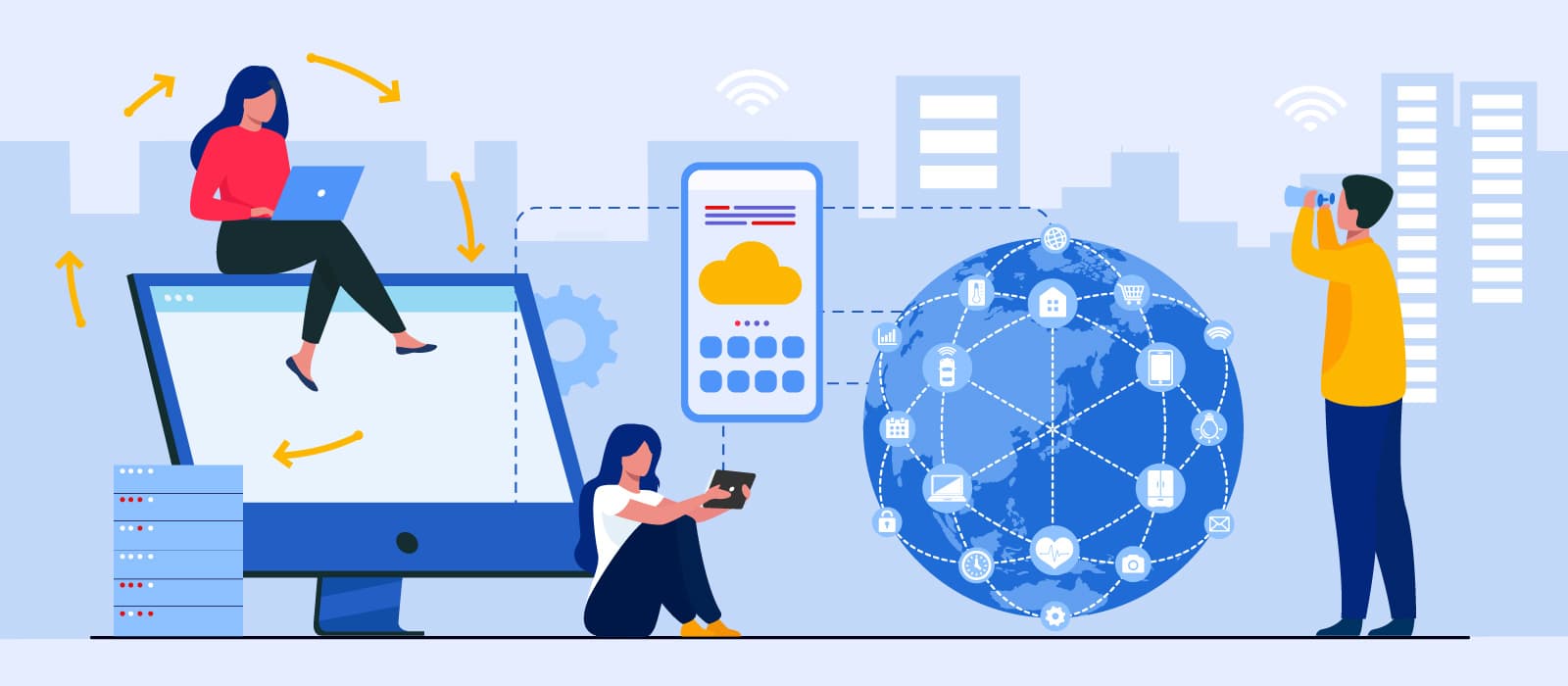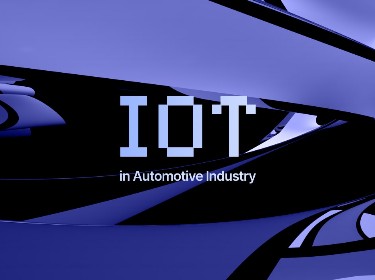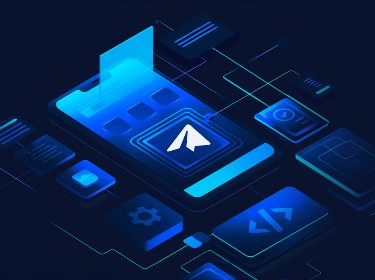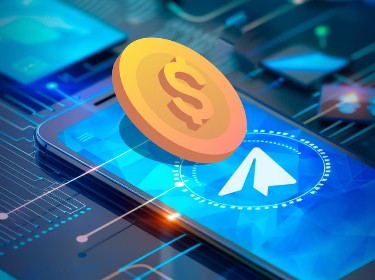The internet of things (IoT) makes our digital world driven by online apps and services even more interconnected. Insightful data collected from devices and sensors keep businesses on track with their operations and benefit consumers with a more personalized experience.
Do you want to get access to your data faster and boost efficiency at work? Are you failing at making informed decisions about production and management? Do you want to accelerate your work operations? Well, you can do all of this all at the same time. With the advent of advanced technology which is the internet of things, you can escalate work efficiency, management, and production.
The IoT has impacted how people commute, work, shop, or simply live. The technology has been gaining popularity all over the world and is now an ongoing trend, connecting machines and objects in businesses and collecting valuable data. But what exactly is the IoT? In simple words, it is the web of physical objects or things equipped with sensors, software, and connected to the internet. The IoT lets devices communicate and share data to ease workflow processes.
Devices in the IoT include things as small as a pill and as major as jet engines. From coffee machines to wearable devices to airplanes, everything is now being connected to the IoT to gather, receive, and send data for better and smarter solutions. It can be said that the internet of things is somewhat an amalgamation of digital and physical universes where data aggregation and analysis plays the key role.
Read on to find out more about the IoT, how it works, its advantages, and the latest trends like smart homes and cities.
What is the history of the internet of things?
The emergence of the IoT goes back to the 1980s when an internet-connected Coca Cola vending machine was installed at Carnegie Mellon University. This smart device was able to report its inventory along with the temperature of the sodas from a distance.
In 1991, Mark Weiser, a computer scientist, expressed the contemporary vision of the IoT in his paper on ubiquitous computing, “The Computer of the 21st Century”. Reza Raji, an internet of things veteran, was the first to demonstrate moving small segments of data to a large set of nodes that could help integrate and automate machines in homes or factories. He described his work as IEEE Spectrum.
The period between 1993 and 1997 saw several companies come forward with their ideation of the IoT. It came into the spotlight when William Nelson Joy (Bill Joy), an American computer engineer, proposed device-to-device communication as a part of his “Six Webs” framework. He showcased his work at the World Economic Forum at Davos in 1999.
During the same year, the phrase “internet of things” was coined by Kevin Ashton of Procter & Gamble. He also described how indispensable Radio Frequency Identification (RFID) tags fit into the IoT environment and how they can be used to track the location of equipment. RFID also allowed using computers to manage processes and streamline the workflow.
The IoT first came to the attention of businesses and manufacturers, and its applications were called machine-to-machine (M2M). But it soon found its way into offices and homes with smart devices such as televisions, speakers, and household appliances being connected, remodeling styles of working and living. A colorful example is the Nest thermostat that allowed customers to adjust the temperature of their home from their smartphones.
How big is the internet of things?
The growth of the IoT has been witnessed by tech analysts all over the world. International Data Corporation (IDC) has estimated, based on the growth of the IoT in recent years, that there will be 55.7 billion devices connected to the IoT by 2025. Industries leading the race to connect devices to the IoT are industrial and automotive, with smart homes and wearable devices coming close.
The rapid growth of the IoT landscape is predicted in various sectors such as enterprise, security devices, automotive, and healthcare. Currently a hundred billion dollar market, it’s expected to grow to over a trillion dollars in just a few years. This is how big the internet of things is and it is only going to get bigger.
IoT as the next stage of the internet
![]()
The internet of things is not only about connecting things to the internet, but also about how it gathers, receives, and sends data to deliver smarter solutions, and in some cases, how it acts upon the data. Sensors can help gather and communicate data in the same environment, or in different environments. This creates a whole new overlay for the global network that is the internet, providing us with even more information and helpful tools.
More benefits of the IoT lie in the way it is set up to extract data, use the insights from the data, digitize, optimize, and more. The functionality of the IoT is also used in the transformation of stage processes, business models, and digital transformation.
Key characteristics of the internet of things
The IoT ecosystem in general is a complex system of interconnected hardware and software. However, there are some key characteristics that apply to all these solutions.
Connectivity enables the IoT network to be accessible and compatible. Interconnected segments of the network can exchange information, contributing to the overall intelligence of the system. This opens the door to innovative business opportunities.
Sensors help gather, generate, and respond to the data created when devices communicate with each other or with the environment. The IoT incorporates pressure and light sensors, GPS, electrochemical, RFID, and more. Accumulated information can then be sent to analytics software in the cloud.
Intelligence. The IoT is the amalgamation of various aspects such as algorithms and computation, engineering, software, and hardware. The collective intelligence of the IoT improves our abilities to respond to demanding situations in a smarter way. It also helps with carrying out tasks more efficiently.
Dynamics. The aim of the internet of things is to collect data using devices from different or similar environments, generate insights, and make conclusions. The state of these devices changes naturally, for instance, if someone is walking or jogging, or if the device is connected or disconnected. The number of devices at a tracked location can also change dynamically over time.
Scalability. IoT networks should be created so that they can be scaled up or down easily as per the requirements. The IoT is being used intensively for automating smart homes, factories, and workplaces. So the IoT’s infrastructure depends upon its current and future scale of engagement and should be designed accordingly.
Interoperability is one of the key characteristics of the internet of things as devices can be built on different hardware and software platforms. They can be integrated with other services having completely different architecture or even legacy systems. These devices also interact using a variety of network protocols. To support such interoperability, components must have proper APIs.
High security. IoT devices are undoubtedly vulnerable to security threats. The benefits of the IoT often overshadow the associated security and privacy concerns. It’s essential for manufacturers and software developers to secure all loopholes so that data can be transferred without any breaches.
Benefits of the internet of things for business
![]()
Businesses around the world are incorporating the IoT into their enterprises to move up to a new level. They do not want to leave any discrepancies and are thus leveraging the internet of things to scale up their businesses.
The benefits of the IoT are numerous and it is to no surprise that many companies have already taken advantage of the opportunities it creates. Let us highlight some of the major benefits of the IoT for business.
- Improved productivity
The IoT enhances the quality of training provided to employees and keeps them updated about their performance. The IoT also helps them interact with clients and form better relationships with their teams to reduce the loopholes in the workflow. The IoT enhances productivity by highlighting gaps and showcasing how to fulfill them to increase the quality of the work done by the team.
- New business opportunities
The IoT interacts dynamically with customers and clients, leading to different business opportunities by showcasing solutions that cater to their needs. The IoT helps offer clients practical solutions that allow you to scale up your business to a new level.
- Enhanced asset utilization
IoT sensors are helpful in keeping a tab on assets such as equipment, machinery, tools, and more. Applying the IoT gives you real-time data along with insights that help you operate your system in a much better way.
For example, imagine that a machine is overheating when you are not around. An IoT system can switch off the equipment and inform you so that you can take immediate action. In some scenarios, you can even be notified beforehand so that you can take preventive measures.
- Real-time analytics
Various IoT applications showcase real-time analytics which helps businesses acquire a birds-eye view of their operations. The insights help them evaluate things, find gaps, manage production, and enhance organizational productivity. With sufficient data on logistic networks, factory floor, supply chain, and other areas, workflow and processes can be operated much better.
- Cost optimization
There is no doubt that the IoT helps businesses manage their budget with greater efficiency. Optimizing workflows across the organization, it allows you to save on production, management, and operations. With the help of advanced technology and sensors, the IoT minimizes the cost of production and enables operations at a greater rate.
- Quality customer service
For any business, quality customer satisfaction is the key to success. The IoT brings a lot to the table when it comes to quality customer service. IoT-enabled devices can be utilized to help your customers track their shipments, allow them to process a transaction through their smartphone, and so much more. The IoT has changed the way we shop and has benefitted both customers and businesses.
See how we’ve used IoT to help BMW improve their dealer showroom services
What is the industrial internet of things?
The industrial internet of things (IIoT) is an industrial framework in which a large number of devices, things, objects, and machines are connected with the use of software and enhanced technologies. In the IoT context, it is also called machine-to-machine technology, Industry 4.0, or the Industrial Internet.
IIoT is an umbrella term for applications and utilizes cases across different industrial areas. It is all about machines, computers, and people leveraging smart industrial operations with the help of enhanced data analytics for the purpose of transformational business outcomes.
The aim of the IIoT is to incorporate sensors, wireless networks, big data, artificial intelligence, and analytics to evaluate and optimize industrial workflows. By working with a big data consulting company, businesses can ensure that the vast amounts of data generated by IIoT systems are effectively managed and analyzed to unlock their full potential.
The impact of the IIoT is particularly significant when applied across an entire supply chain, enhancing material delivery and production efficiency. Increasing workforce productivity and cost savings are two indispensable aspects of the IIoT. In the long run, these technologies help generate new revenue streams for businesses.
Benefits of the internet of things for consumers
![]()
The IoT enhances our lifestyle. It lets us live in a time of smarter, measurable, and comfortable surroundings. Listening to music, setting timers, or getting information has become much more convenient with the use of smart devices like Google Homes and Amazon Firestick. Let’s point out some of the greater perks of the internet of things for consumers:
- Ultimate convenience. The IoT can take over some of the tasks that we are not very fond of, like checking if your fridge is running low on milk or juice. It automates chores and fulfills necessities like keeping a tab on old food or medicines.
- Energy efficiency. The internet of things has proven beneficial in saving energy as well. Using adjustable lighting and heating allows for greater energy efficiency along with decreased utility bills.
- Personalized product offering. Using sensors, heat maps, and smart apps companies are better able to understand the requirements of their customers. Customers are provided with tailored products that cater to their needs.
- Healthier environment. Devices with sensors provide insights into how noisy or polluted our environment can be. Self-driving cars and smart cities could change how we build and manage our public spaces leading to a greener and healthier living environment.
The internet of things and smart homes
With the IoT in place, convenience and comfort have become major selling points for a variety of products for the household. The installation of sensors in security systems, smart bulbs, thermostats, and other devices has given people a whole new lifestyle. Not only has it made homes more comfortable, but it has also become easy on the pocket, saving money on bills. Smart homes are proven to be energy efficient, and this technology is making its way into thousands of homes across the world.
Elderly people are benefiting in particular from smart homes since they no longer have to struggle to turn devices on and off on a regular basis. Not only do smart homes have practical applications that are useful, but they are also aesthetically pleasing, giving homes a modern and contemporary look with these cutting-edge gadgets.
Learn more about how our Smart Home App improves people's lives by giving them complete control over their smart devices
Role of the internet of things in smart cities
Smart cities are becoming the norm in metropolitan areas. Smart cities utilize IoT devices to collect and evaluate data to enhance infrastructure, public utilities, services, etc. The population of smart cities is surging due to their improved quality of life.
Smart cities provide their residents with an efficient lifestyle with high standards. Various innovations are being incorporated to develop smart cities such as wearable devices for police officers to enhance awareness and make quicker and better decisions. Other innovations are smart trash collection, smart city platforms, open data, and more. The impact of smart cities is positive for residents in terms of the following aspects:
- Security. Cities are adopting innovative ideas to improve the safety of their residents. Devices such as real-time crime mapping, gunshot detection, and predictive policing tools are being utilized to help find potential hotspots and prevent crimes from happening. Research shows that incorporating these technologies could reduce crime rates and fatalities by 8-10%.
- Commute. Smart cities are introducing new means of transportation with automated vehicles that ensure the safety of drivers, provide directions, optimize traffic, and decrease travel time.
- Health. The IoT is setting a bar for new strategies to prevent and treat chronic diseases. For instance, China has used IoT devices powered by facial recognition to track those affected by Coronavirus and curb the spread of the disease. Using highly sophisticated technology for preventative measures has proven to be effective in cities with a high disease burden and low access to care, such as Lagos in Nigeria.
- Environment. IoT devices are proven to be helpful in minimizing heat production and electricity, making the environment greener and cleaner. Smart cities are also using connected hardware and software for optimizing water consumption. IoT applications such as smart irrigation systems, water leakage, quality, and consumption monitoring could save a city from 25 to 80 cubic meters of water per person daily.
Find out how we’ve used IoT to optimize water hauling processes
What about IoT technology security?
![]()
Yes, it is all very charming to use advanced technology and gadgets that minimize effort and save you time. However, there are several IoT security issues that cannot be ignored and need serious attention. Hackers have a knack for finding loopholes and exploiting vulnerabilities in environments where data exchange is prevalent. They attack the apps, the gateways, data centers, the devices themselves, and more.
What’s worrisome is that some devices may have malware on them before you even get them. Once they’re installed, they corrupt the connected network and put its entire security at stake. Here are some potentially exploitable weak spots of IoT security:
- Unpatched vulnerabilities. Sometimes there’s a connectivity issue in the devices forcing users to manually update and set the devices. This increases the chance of getting attacked due to outdated software. Hackers are quick at discovering back doors in older software and exploiting users this way.
- Exploitable APIs. APIs are a gateway to command and control centers. There are cases of APIs being routinely attacked with a variety of penetration methods.
- Weak authentication. Devices with security passwords and no other factors of authentication are often easy targets for hackers. If the password is not timely updated, it may be vulnerable to unwanted remote access.
Privacy in the internet of things
Apart from security issues, consumers are very much concerned about privacy. IoT devices now know your daily schedule better than yourself, like when you wake up, brush your teeth, have coffee, leave home, and more. The question of who has access to this data, other than you, is a matter of concern. According to reports, a lot can be known about a person by simply gaining access to the data in IoT devices, and this is quite alarming.
Let’s brush through a list of some of the major IoT privacy issues:
- Unprotected data flows
The amount of data that IoT devices generate can be disturbing. Some reports show that households within just one city generate hundreds of millions of discrete data points on a daily basis. Without any protective measures, the result is more entry points for hackers and sensitive information being left out in the open.
- Undisclosed personal information
Companies could obtain access to personal data when customers agree to the terms and conditions for the provision of services. For instance, an insurance company can get access to information about your driving habits using a connected car when calculating your insurance rate.
- Eavesdropping
Invading homes virtually can be easily done by manufacturers or hackers using a connected device. A German researcher demonstrated this by intercepting unencrypted data from a smart device to reveal what television show someone was watching at that moment.
Each of these problems could hamper consumers’ desire to go ahead and purchase connected products. This would prevent the IoT from fulfilling its true potential.
The internet of things and data
The IoT generates a vast amount of data that comes in various forms such as videos, voice requests, temperature readings and others. This growing source of IoT metadata needs to be managed and fed into NoSQL databases to bring onboard structure to unstructured content. Further, analytical systems create new levels of understanding and provide the insights needed to improve our digital environments.
How does the internet of things collect this data? Let us explain it to you.
An IoT device contains one or more sensors to collect data. Different sensors have different roles depending on their usage. For instance, sensors inside industrial machines are used to measure temperature, a security camera might have a proximity sensor, and your home weather station probably has a humidity sensor. All this sensor data is transmitted through Wi-Fi, 4G, 5G, and more.
There are different types of data that these sensors collect. Here’s a breakdown of the types of sensor data:
- Status data is the most basic type of information gathered. For example, whether an appliance is off or on, whether there are available spots at a property, and more. This data is used for decision-making, planning, and maintenance.
- Location data tracks the movement of an object or a person. Connected devices make use of location data for fleet management, asset tracking, employee monitoring, shipment tracking, and other management tasks.
- Automation data lets IoT systems take control of devices inside a house, vehicles on the road, and other moving parts of any system. Leveraging automation data is a complex process due to the high chance of errors like accidental lockdown or traffic accidents. Nevertheless, with security practices, a large number of IoT systems will depend on automation data.
- Actionable data is an addition to status data. The device captures information, processes it, and transforms it into easy-to-carry-out instructions. It is often used in forecasting and prediction, energy consumption, and workplace efficiency optimization. It can also be used in long-term decision-making.
IoT in the context of edge computing and the cloud
![]()
Edge computing is based on appliances placed close to IoT devices managing the flow of data from those devices and making basic assessments of this data on the spot. Once the data is processed, it goes to a centralized data center, or even more often it will end up in the cloud. The elastic nature of cloud computing is suitable for IoT machines where data is segmented or sent irregularly.
Organizations often incorporate a combination of both edge computing and cloud. Cloud computing is mostly used for the storage and execution of applications and processes. Edge computing, on the other hand, is used particularly when processing confidential data. It handles data faster and more accurately.
How does 5G fit into the internet of things and sharing data?
IoT devices incorporate various ways of connecting and sharing data depending on the requirements. However, the most common method to connect and share data is through wireless connectivity. Wi-Fi, Zigbee or Bluetooth Low Energy, and Ethernet are used in homes and workplaces. Some IoT devices use LTE or satellite connections for interaction.
It is argued that the usage of 5G networks would have a positive impact on IoT projects in the near future. Since the 5G network has the resilience to fit as many as one million 5G devices in a square kilometer, it has the potential to increase dataflow and accelerate the generation of insightful analytics.
Experts suggest that the 5G network will become the underlying fabric of an ecosystem of fully connected smart sensors and objects. 5G is expected to encourage a new style of living and add value for businesses in various ways in the form of manufacturing and connected products, smart cities, connected vehicles, and healthcare.
Artificial intelligence giving life to IoT data via analytics
It’s no wonder that companies are relying on artificial intelligence to manage data that comes from billions of internet of things devices. With so many layers attached to the IoT in terms of its connectivity, storage, functionality, system integration, extracting, and managing all the data exuded from these chatty systems becomes a major task.
With artificial intelligence coming into play, accessing and simplifying data obtained from IoT networks is becoming easier. Merging AI with the IoT is not just transforming the way businesses process their information, their interaction with customers is also evolving. AI-powered systems help companies extract important data about their customers, employees, suppliers, partners, and more.
The IoT serves as the binding mechanism for distributed systems, whereas AI manages all the devices and evaluates data to deliver better products and services to the consumer. This symbiosis is proven to be very fruitful for both parties.
IoT business transformation as a step into the future
The internet of things has come a long way from an idea about a refrigerator that tracks a person’s food supply. Our modern digitized world is now interwoven with smart devices and sensors with embedded systems powered by other emerging technologies such as artificial intelligence.
Key performance indicators, statistics, consumer shopping behavior, machine health status parameters, etc. are being gathered from a multitude of data points to provide businesses with hands-on intelligence and improve their quality of services.
Setting up IoT hardware and software is not an easy task without the help of a team of qualified engineers and software architects. Don’t hesitate to partner with our internet of things consulting team on your next project if you would like to avoid the hassle and overcome data privacy and security issues.




